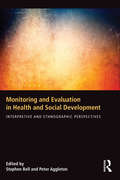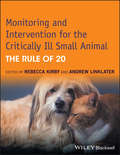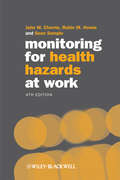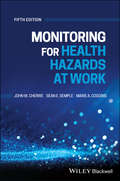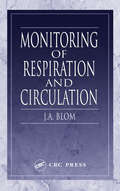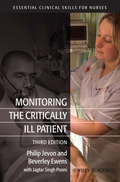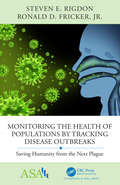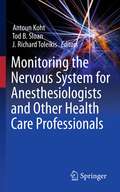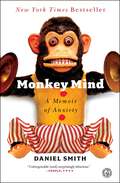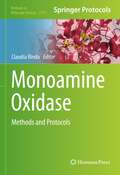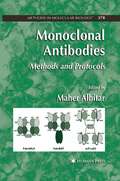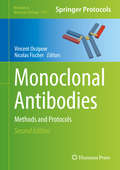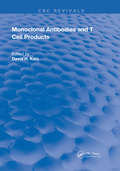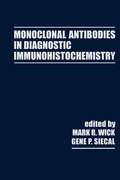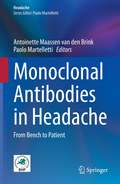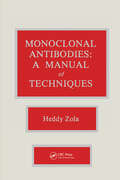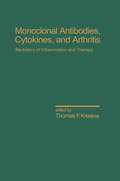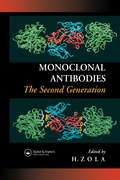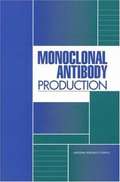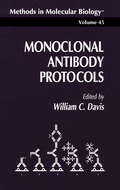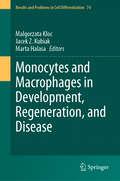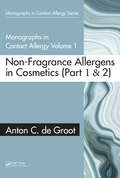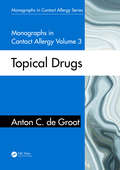- Table View
- List View
Monitoring and Evaluation in Health and Social Development: Interpretive and Ethnographic Perspectives
by Stephen Bell Peter AggletonNew approaches are needed to monitor and evaluate health and social development. Existing strategies tend to require expensive, time-consuming analytical procedures. The growing emphasis on results-based programming has resulted in evaluation being conducted in order to demonstrate accountability and success, rather than how change takes place, what works and why. The tendency to monitor and evaluate using log frames and their variants closes policy makers’ and practitioners’ eyes to the sometimes unanticipated means by which change takes place.Two recent developments hold the potential to transcend these difficulties and to lead to important changes in the way in which the effects of health and social development programming are understood. First, there is growing interest in ways of monitoring programmes and assessing impact that are more grounded in the realities of practice than many of the ‘results-based’ methods currently utilised. Second, there are calls for the greater use of interpretive and ethnographic methods in programme design, monitoring and evaluation.Responding to these concerns, this book illustrates the potential of interpretative methods to aid understanding and make a difference in real people’s lives. Through a focus on individual and community perspectives, and locally-grounded explanations, the methods explored in this book offer a potentially richer way of assessing the relationships between intent, action and change in health and social development in Africa, Asia, Europe and the Americas.
Monitoring and Intervention for the Critically Ill Small Animal: The Rule of 20
by Andrew Linklater Rebecca KirbyMonitoring and Intervention for the Critically Ill Small Animal: The Rule of 20 offers guidance for assessing the patient, interpreting diagnostic test results, and selecting appropriate monitoring procedures. Based on Rebecca Kirby's time-tested Rule of 20, with a chapter devoted to each item on the checklist Provides comprehensive guidance for monitoring a critically ill small animal patient Emphasizes the interplay of each parameter with one another Designed for fast access on the clinic floor, with potentially life-saving ideas, tips, lists and procedures Presents tables, schematics, algorithms, and drawings for quick reference
Monitoring for Health Hazards at Work
by Sean Semple John Cherrie Robin HowieMonitoring for Health Hazards at Work has become an essential companion for students and professionals in occupational hygiene, offering a concise account of the dangers faced in a wide variety of work environments and giving practical, step-by-step guidance to gauge exposure. It includes: Coverage of most major health hazards: airborne dust, fibres, gases, vapours, noise, radiation, and biological agents Accounts of the latest equipment and techniques required to monitor such hazards Full guidance on how to undertake risk assessments Now thoroughly revised and restructured by an eminent new team of authors, the fourth edition brings this valuable handbook right up to date.
Monitoring for Health Hazards at Work
by Sean Semple John Cherrie Marie CogginsMONITORING FOR HEALTH HAZARDS AT WORK Monitoring for Health Hazards at Work remains the seminal textbook on measuring and controlling the risk of workplace exposure to physical, chemical, and biological hazards. Designed for students studying occupational hygiene and exposure science, this comprehensive and accessible volume provides step-by-step guidance on identifying hazards and quantifying their risks in various workplace environments. Complete with checklists and practical examples, the authors present clear explanations of all types of hazards that can arise in the workplace, including dust, particles, fibrous aerosols, gases, vapours, and bioaerosols.The fifth edition features revised material throughout, and remains an essential resource for students and professionals in occupational hygiene, reflecting global standards and recent developments in monitoring equipment, modelling methods, exposure assessment, and legislation on workplace safety. Several new or substantially revised chapters cover topics such as human biomonitoring, exposure modelling, hazardous substances, physical agents, evaluating ventilation, PPE, and other control measuresUpdated sections discuss the equipment currently available, the importance of risk communication, assessing dermal and inadvertent ingestion exposures, and moreExamines common workplace comfort issues such as noise, vibration, heat and cold, and lightingOffers practical advice on conducting and presenting risk assessments and reportsDiscusses the future of the development and application of hazard measurement equipment and methodsMonitoring for Health Hazards at Work, is required reading for students and professionals in occupational hygiene, environmental health and safety, occupational health and safety, and exposure science.
Monitoring in Anesthesia and Perioperative Care
by David L. Reich James B. Eisenkraft Andrew B. Leibowitz Marc E. Stone Coeditors Ronald A. Kahn Alexander J. C. MittnachtAnesthesiologist and other medical specialists document the current art and science of peri-operative patient monitoring and address the systems-based practice issues that drive the health care industry. Writing for medical students and practitioners, they discuss such topics as medico-legal implications of monitoring, cardiac output and intravascular volume, neurological intra-operative and electro-physiologic monitoring, endocrine testing in the operating room, and post-anesthesia care unit assessment scales. Annotation ©2011 Book News, Inc. , Portland, OR (booknews. com)
Monitoring of Respiration and Circulation
by J. A. BlomMonitoring of Respiration and Circulation provides biomedical engineers with a comprehensive source for understanding the variables of the respiratory and circulatory systems, which indicate how well these systems are functioning. This book covers techniques for measuring the variables, including modeling, medical instrumentation, and signal proces
Monitoring the Critically Ill Patient
by Philip Jevon Jagtar Singh Pooni Beverley EwensMonitoring the Critically Ill Patient is an invaluable, accessible guide to caring for critically ill patients on the general ward. Now fully updated and improved throughout, this well-established and handy reference guide text assumes no prior knowledge and equips students and newly-qualified staff with the clinical skills and knowledge they need to confidently monitor patients at risk, identify key priorities, and provide prompt and effective care.This new edition includes the following five new chapters:Monitoring the critically ill childMonitoring the critically ill pregnant patientMonitoring the patient with infection and related systemic inflammatory responseMonitoring a patient receiving a blood transfusionMonitoring pain
Monitoring the Health of Populations by Tracking Disease Outbreaks: Saving Humanity from the Next Plague (ASA-CRC Series on Statistical Reasoning in Science and Society)
by Steven E Rigdon Ronald D. Fricker, Jr.With COVID-19 sweeping across the globe with near impunity, it is thwarting governments and health organizations efforts to contain it. Not since the 1918 Spanish Flu have citizens of developed countries experienced such a large-scale disease outbreak that is having devastating health and economic impacts. One reason such outbreaks are not more common has been the success of the public health community, including epidemiologists and biostatisticians, in identifying and then mitigating or eliminating the outbreaks. Monitoring the Health of Populations by Tracking Disease Outbreaks: Saving Humanity from the Next Plague is the story of the application of statistics for disease detection and tracking. The work of public health officials often crucially depends on statistical methods to help discern whether an outbreak may be occurring and, if there is sufficient evidence of an outbreak, then to locate and track it. Statisticians also help collect critical information, and they analyze the resulting data to help investigators zero in on a cause for a disease. With the recent outbreaks of diseases such as swine and bird flu, Ebola, and now COVID-19, the role that epidemiologists and biostatisticians play is more important than ever. Features: · Discusses the crucial roles of statistics in early disease detection. · Outlines the concepts and methods of disease surveillance. · Covers surveillance techniques for communicable diseases like Zika and chronic diseases such as cancer. · Gives real world examples of disease investigations including smallpox, syphilis, anthrax, yellow fever, and microcephaly (and its relationship to the Zika virus). Via the process of identifying an outbreak, finding its cause, and developing a plan to prevent its reoccurrence, this book tells the story of how medical and public health professionals use statistics to help mitigate the effects of disease. This book will help readers understand how statisticians and epidemiologists help combat the spread of such diseases in order to improve public health across the world.
Monitoring the Nervous System for Anesthesiologists and Other Health Care Professionals
by Antoun Koht J. Richard Toleikis Tod B. SloanWritten and edited by outstanding world experts, this is the first portable, single-source volume on intraoperative neurophysiological monitoring (IOM). It is aimed at all members of the operative team - anesthesiologists, technologists, neurophysiologists, surgeons, and nurses. Now commonplace in procedures that place the nervous system at risk, such as orthopedics, neurosurgery, otologic surgery, vascular surgery, and others, effective IOM requires an unusually high degree of coordination among members of the operative team. The purpose of the book is to help team members acquire a better understanding of one another's roles and thereby to improve the quality of care and patient safety. * Concise and thorough * Comprehensive coverage of monitoring techniques, from deep brain stimulation to cortical mapping * Synoptic coverage of anesthetic management basics * 23 case-based examples of procedures, including surgery of the aortic arch, ENT and anterior neck surgery, intracranial aneurysm clipping, and interventional neuroradiology * Monitoring in the ICU and of cerebral blood flow
Monitoring the Nervous System for Anesthesiologists and Other Health Care Professionals
by Antoun Koht J. Richard Toleikis Tod B. SloanWritten and edited by outstanding world experts, this is the first portable, single-source volume on intraoperative neurophysiological monitoring (IOM). It is aimed at all members of the operative team - anesthesiologists, technologists, neurophysiologists, surgeons, and nurses. Now commonplace in procedures that place the nervous system at risk, such as orthopedics, neurosurgery, otologic surgery, vascular surgery, and others, effective IOM requires an unusually high degree of coordination among members of the operative team. The purpose of the book is to help team members acquire a better understanding of one another's roles and thereby to improve the quality of care and patient safety. * Concise and thorough * Comprehensive coverage of monitoring techniques, from deep brain stimulation to cortical mapping * Synoptic coverage of anesthetic management basics * 23 case-based examples of procedures, including surgery of the aortic arch, ENT and anterior neck surgery, intracranial aneurysm clipping, and interventional neuroradiology * Monitoring in the ICU and of cerebral blood flow
Monkey Mind: A Memoir of Anxiety
by Daniel SmithAnxiety once paralyzed Daniel Smith over a roast beef sandwich, convincing him that a choice between ketchup and barbeque sauce was as dire as that between life and death. It has caused him to chew his cuticles until they bled, wear sweat pads in his armpits, and confess his sexual problems to his psychotherapist mother. It has dogged his days, threatened his sanity, and ruined his relationships. <P><P>In Monkey Mind, Smith articulates what it is like to live with anxiety, defanging the disease with humor, traveling through its demonic layers, and evocatively expressing its self-destructive absurdities and painful internal coherence. With honesty and wit, he exposes anxiety as a pudgy, weak-willed wizard behind a curtain of dread and tames what has always seemed to him, and to the tens of millions of others who suffer from anxiety, a terrible affliction.
Monoamine Oxidase: Methods and Protocols (Methods in Molecular Biology #2558)
by Claudia BindaThis detailed book examines the main methods to study mammalian monoamine oxidases (MAOs), ranging from cell biology to computational chemistry. Beginning with techniques on how to obtain pure samples of MAO A and MAO B, the volume continues by covering assays and techniques used to measure MAO enzymatic activity and perform inhibition studies, methods to address cellular localization and function of MAOs, either in cell lines or in animal models, as well as computational methods applied to rational drug design approaches that are used to develop new MAO inhibitors. Written for the highly successful Methods in Molecular Biology series format, chapters include introductions to their respective topics, lists of the necessary materials and reagents, step-by-step and readily reproducible laboratory protocols, and tips on troubleshooting and avoiding known pitfalls. Authoritative and practical, Monoamine Oxidase: Methods and Protocols serves as a vital resource for scientists who are interested in studying MAOs and other similar amine oxidase enzymes.
Monoclonal Antibodies
by Maher AlbitarThis book examines a collection of state-of-the-art methods that employ monoclonal antibodies in a clinical setting. The chapters offer in-depth description for generating mouse and recombinant humanized antibodies, and a comprehensive review of how antibodies are being used in bead-based methods for measuring proteins. This field will continue to expand and provide new and innovative techniques in the laboratory and as a basis that complements targeted therapy.
Monoclonal Antibodies
by Vincent Ossipow Nicolas FischerMonoclonal Antibodies: Methods and Protocols, Second Edition expands upon the previous edition with current, detailed modern approaches to isolate and characterize monoclonal antibodies against carefully selected epitopes. This edition includes new chapters covering the key steps to generate high quality monoclonals via different methods, from antigen generation to epitope mapping and quality control of the purified IgG. Chapters are divided into four parts corresponding to four distinct objectives. Part I covers monoclonal antibody generation, Part II deals with monoclonal antibody expression and purification, Part III presents methods for monoclonal antibody characterization and modification, and Part IV describes selected applications of monoclonal antibodies. Written in the highly successful Methods in Molecular Biology series format, chapters include introductions to their respective topics, lists of the necessary materials and reagents, step-by-step, readily reproducible laboratory protocols, and tips on troubleshooting and avoiding known pitfalls. Authoritative and practical, Monoclonal Antibodies: Methods and Protocols, Second Edition provides crucial initial steps of monoclonal antibody generation and characterization with state-of-the art protocols.
Monoclonal Antibodies & T Cell Products (Routledge Revivals)
by David H. KatzFirst Published in 1982, this book offers a full, comprehensive guide into the applications of Monoclonal Antibodies. Carefully compiled and filled with a vast repertoire of notes, diagrams, and references this book serves as a useful reference for Students of Medicine, and other practitioners in their respective fields.
Monoclonal Antibodies in Diagnostic Immunohistochemistry (Clinical and Biochemical Analysis)
by Gene P. Siegal Mark R. WickThis book describes the methodology of monoclonal antibody-mediated immunohistochemistry, as applied to practical tissue diagnosis. It focuses on human disease and discusses the spectrum of monoclonal antibodies in relation to its utility in solving differential diagnostic problems.
Monoclonal Antibodies in Headache: From Bench to Patient (Headache)
by Paolo Martelletti Antoinette Maassen van den BrinkIntended to promote a more appropriate and modern therapeutic approach to migraine management, this book is the first to deal with monoclonal antibodies in this context. Authored by the most respected migraine experts from around the globe and drawing on the lessons learned in both clinical trials and clinical practice, it reviews the current state of knowledge on this important therapeutic innovation, which has produced impressive data in randomized controlled trials, and the efficacy and safety of which have been confirmed in day-to-day real-world use. Given its scope, the book will appeal to a broad range of specialists, including pharmacologists, clinical pharmacologists, neurologists and internists, but also to residents and medical students.
Monoclonal Antibodies: A Manual of Techniques
by Heddy ZolaThis book describes, in detail, tested techniques for the produc-tion and use of monoclonal antibodies. It covers those aspects of interest to all scientists working with monoclonal antibodies and presents methods in a step-by-step format for easy refer-ence. The text serves as a laboratory manual; and discusses rationale behind each method, and th
Monoclonal Antibodies: Cytokines and Arthritis, Mediators of Inflammation and Therapy
by Thomas F. KresinaPresents a sampling of new and novel approaches to the amelioration of musculoskeletal disease pathology, emphasizing prevention and therapy. Where applicable, these new technologies are focused on their application to human autoimmune diseases, but the volume mainly discusses and details the use of
Monoclonal Antibodies: The Second Generation
by Heddy ZolaA review of what needs to be done to realise the potential of monoclonal antibodies. The book assesses the competing technologies with advice on the best approach for a particular situation.
Monoclonal Antibody Production
by National Research CouncilInformation on Monoclonal Antibody Production
Monoclonal Antibody Protocols
by William C. DavisMonoclonal Antibody Protocols provides researchers in biomedical, agricultural, and biological science with a set of detailed, easy-to-follow methods for developing and using monoclonal antibodies. The protocols emphasize techniques that optimize the outgrowth of hybridomas from primary cultures of fused cells and the use of an alternative, electric-field-mediated cell fusion technique to increase the yield of hybridomas. The book stresses antibodies produced in mice, but includes methods of producing xenogeneic hybrids that yield human, bovine, equine, and porcine monoclonal antibodies. With its detailed instructions, its comments on how to alter the various steps of a protocol in order to accommodate different materials, and its hints and tips that often make the difference between success and failure, Monoclonal Antibody Protocols provides you with a ready and indispensable source of information for preparing and using monoclonal antibodies successfully in your laboratory.
Monocytes and Macrophages in Development, Regeneration, and Disease (Results and Problems in Cell Differentiation #74)
by Jacek Z. Kubiak Malgorzata Kloc Marta HalasaThe study and therapeutic application of macrophages is a rapidly developing field. Tremendous progress has been made in understanding the phenotypes and functions of macrophages in healthy and diseased tissues and organs. Following the great success of Volume 62: "Macrophages - Origin, Functions and Biointervention" published in this series, this new book now focuses on the role of monocytes and macrophages in development, regeneration and disease. This new volume offers an overview of the latest developments in monocyte and macrophage subtypes and functions across various tissues including adipose tissue, bones, liver, lungs, testes, and the nervous system. The book also reviews existing and potential therapies targeted towards the macrophages and describes their homeostatic functions. It explores how macrophage cell cycle, metabolism, mitochondrial activity, histone acetylation status, and interaction with the extracellular matrix contribute to changes in macrophage phenotype and function in health and disease. Additionally, it examines the interactions between macrophages and cancer cells, bacteria, helminth parasites, and their role in the colonization and spread of HIV. For ease of reference, the volume is divided into three sections: Part I Nonimmunologic and immunologic functions of monocytes/macrophages Part II Tissue/organ specific functions of macrophages Part III Macrophage functions and dysfunction in diseases This book will be of interest to researchers working in the fields of developmental biology, immunology, cancer research, and therapeutic applications. It is written to inform and inspire experts and newcomers to the field of macrophages.
Monographs in Contact Allergy, Volume 1: Non-Fragrance Allergens in Cosmetics (Part 1 and Part 2) (Monographs in Contact Allergy #1)
by Anton C. de GrootMonographs in Contact Allergy, Volume 1: Non-Fragrance Allergens in Cosmetics (Part 1 and Part 2) is the first 2-part volume in an exciting series on contact allergy. It presents over 500 natural or synthetic chemicals and compounds which have caused allergic contact dermatitis in cosmetic products. Included here are INCI names, synonyms, description/definition, CAS and EU numbers, chemical class, function in cosmetics, molecular formula, structural formula and advice on patch tests. A full literature review is given of patch testing in patients, case reports of cosmetic allergic contact dermatitis, irritant contact dermatitis, photosensitivity, immediate contact reactions and systemic side effects. This text is suitable for anyone with an interest in contact allergy, from university students to professionals, and all readers will find this informative and detailed series an invaluable resource. Key Features: Monographs of all known non-fragrance chemicals and substances which have caused allergic contact dermatitis from their presence in cosmetic products Provides lists of all functional groups (such as antioxidants, preservatives, artificial nail building, emollients, hair dyeing, hair colorants) in both the EU and US formats and all chemicals in these groups which have caused cosmetic allergy Presents an alphabetical list of all synonyms indicating their INCI names Reported cross-reactions, pseudo-cross-reactions and co-reactions, patch test sensitization and presence in cosmetic products (including data from FDA’s Voluntary Cosmetic Registration Program) and chemical analyses are discussed Covers an extensive amount of information to benefit dermatologists, allergists, and non-medical professionals involved with the research, development and marketing of cosmetic products
Monographs in Contact Allergy, Volume 3: Topical Drugs (Monographs in Contact Allergy #4)
by Anton C. de GrootThis third volume in an exciting and detailed series on contact allergens provides monographs of all 384 topical drugs which have caused contact allergy/allergic contact dermatitis. The monographs present: Identification section; Contact allergy (general population, patients with dermatitis, case reports and case series); Cross-reactions; Patch test sensitization; Photocontact allergy; and Immediate contact reactions (contact urticaria). Separate chapters present an overview of all aspects of allergic contact dermatitis to topical drugs, contact allergy to non-drug ingredients in topical pharmaceuticals and a preview of delayed-type allergy to systemic drugs (to be discussed in Volume 4). Key Features: Presents monographs of all known topical drugs which have caused contact allergy/allergic contact dermatitis Provides a full literature review of relevant topics of allergenic topical drugs Identifies IUPAC names, synonyms, CAS and EC numbers, structural and chemical formulas, Merck Index monographs, and advises on patch testing Presents non-drug allergens in topical pharmaceuticals Covers an extensive amount of information to benefit dermatologists, allergists, and all others interested in drug allergy
